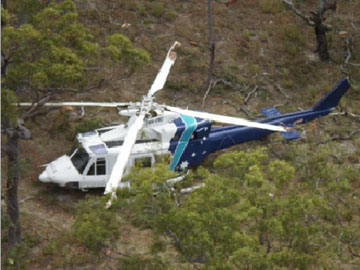
A helicopter accident at Horn Island has shown the challenges that can accompany night operations, as well as the speed with which things can suddenly go wrong.
The accident occurred on 13 June 2013. At about 7.24 pm, a Bell 412 helicopter departed Horn Island, Queensland on a training flight to Prince of Wales Island in the Torres Strait. It was a dark night with a small crescent moon and no discernible horizon. On board was the pilot flying (PF) who was under instruction, a training pilot, and a crewman. The purpose of the flight was to conduct several practice approaches using a searchlight to illuminate the ground. Each approach would be conducted to about treetop height, from where a go-around was to be commenced. The manoeuvres were demanding, and would require a high degree of precise flying.
Earlier in the day, the crew had positioned a strobe light at the target location, so that it would be visible on the night flight.
Having returned to the location for the training, they set about conducting their first practice approach, flying towards the strobe as they descended from 2,000 ft.
At 1,000 ft above the ground, the crewman opened and secured the cabin door. Due to the wind rush he did not look outside continuously until reaching about 400 ft, after which time he was to provide instructions to guide the pilot to the landing area once the PF lost sight of the strobe beneath the helicopter.
Due to the wind rush he did not look outside continuously until reaching about 400 ft, after which time he was to provide instructions to guide the pilot to the landing area once the PF lost sight of the strobe beneath the helicopter.
As they drew nearer to the strobe, the training pilot looked out of the cockpit to confirm all was well to continue a visual approach. When he looked back, he saw that they were descending at a high rate and that the airspeed was below 35 knots. He called ‘Go around’. As there was no immediate response, he repeated the call to go around.
Although the PF commenced a go-around and responded ‘Going around,’ the crewman observed that the helicopter was still descending rapidly and approaching the trees. He called ‘Climb, climb, climb.’ Despite the actions of the pilot, the descent continued and he again called ‘We are going backwards, trees, climb, climb, climb!’
The training pilot took the controls to assist with the go-around and then became aware of the trees in his peripheral vision. As the helicopter descended into the trees, he called ‘Brace, brace, brace!’
The helicopter hit the ground heavily and remained upright.
The crew were uninjured, but the helicopter was substantially damaged. They shut down the helicopter and discharged flares from the accident site, to assist rescuers in locating them.
The helicopter operator hypothesised that the high rate of descent and decreasing airspeed resulted in a vortex ring state—an aerodynamic condition in which the helicopter’s own downwash recirculates, with a potential loss of control.
As a result of this accident, the helicopter operator is conducting a management review into a Flight Safety Instruction that will prohibit unaided (non-night vision goggles) remote landings at night.
Read the report: Collision with terrain involving Bell 412, VH-EMZ, 12 km west-south-west of Horn Island Airport, Queensland, on 13 June 2013, which includes links to useful research and articles about night operations.


